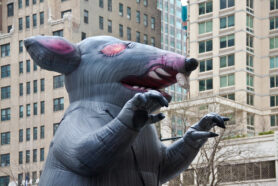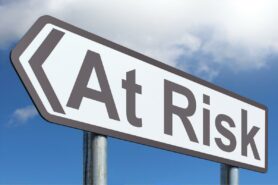Zoonoses: opening a can of worms
New neighbors in the concrete jungle
These days, you can hear the word zoonosis everywhere: in thousands of news articles, podcasts, television shows, and often to describe the recent coronavirus that changed our lives. Like many pandemics from the past, this one started as an infectious disease in wild animals that jumped to humans. Thus, should we be afraid of wild animals living in our cities and neighborhoods? The recent events question our relationships with wildlife, especially when it starts moving closer to our homes.
Zoonotic disease risks from wildlife in the Netherlands

Inflatable rat displayed in a protest in New York City
Though COVID-19 originated far away, the next pandemic could arise closer to you. Despite the inability of the World Health Organization’s teams to trace the origin of the COVID-19 virus, virologists assume that it was originally transmitted to humans from animals – most likely bats and an unknown intermediary. Not only can livestock represent serious risks, but you may also be in increasing proximity to wild animals such as rats, as their populations have been growing in urban areas. As bleak as this may sound, zoonoses expert Dr. Miriam Maas states that people should remain calm but careful, given these diseases often emerge from the way we collectively interact with nature.
When asked about the risk of a new disease emerging from wild animals in the Netherlands, Dr. Maas replies: “looking at the numbers of human patients, the risk is not that high compared to other infectious diseases”, mainly because wildlife remains a “Ver-van-mijn-bed-show” for most people. Still, she advises anyone encountering wild animals to remain cautious and to avoid contact as they can carry pathogens – viruses, bacterias, and other infectious organisms. She also emphasizes the need to study their germs, as “every patient we can avoid is important” and adds that “one of the things that people don’t realize is that animals don’t necessarily get sick from the zoonotic pathogen”, but this does not mean that they are not carrying one.
Zoonotic diseases have affected the Netherlands in the past, such as the Q-fever outbreak, which took place between 2007 and 2010. Current examples of diseases emerging from wildlife in the Netherlands include ticks transmitting Lyme disease, warblers carrying the West Nile Virus, and rats spreading leptospirosis. All these diseases are being rigorously monitored by researchers at universities and public health institutes such as the Dutch RIVM – where Dr. Maas works.
Between green cities and risk management

Summer in Juliana Park in Utrecht
Although it may seem strange to talk about the dangers that wild animals represent in the context of a biodiversity crisis, there is often a balance to be found between preserving nature and minimizing health risks. For example, despite the positive effects of green spaces in cities for people, they may also attract wildlife, and can become a source of danger. Dr. Maas’s recent research has focused on this topic, as she works on making cities greener while reducing risks, by promoting the installation of anti-rat garbage bins, for instance. With her work, she hopes to understand what attracts wildlife to urban green spaces and how we can keep the dangerous animals away for the sake of everyone.
For instance, can architectural projects integrating wildlife into urban landscapes such as bat-friendly bridges represent a risk to people? Dr. Maas asserts that such solutions require a lot of preparation and consideration as it is very difficult to make changes in the environment and be certain of the results: “We try to think of all the things, but you never know exactly what is going to happen”. What remains a priority, is to effectively inform passersby of the risks and of the practices to follow if you encounter an animal.
What can you do?

“There are risks in life, and zoonotic diseases are one of them, but it doesn’t mean we shouldn’t do anything, we just need to be aware of these risks, it’s just like wearing a seatbelt in a car”
The emergence of a disease of animal origins like COVID-19 is symptomatic of humankind’s behavior towards wildlife. Does this mean you should avoid contact with wild animals you come across? Yes! They represent a real risk, whether they look sick or not. Does this mean you should be scared by the idea of encountering one? Absolutely not, according to Dr. Maas.
Dr. Maas says that, in the Netherlands, the number of zoonotic diseases is not increasing per se – the public just recently started to consider it as a serious threat, although the subject has been around in scientific circles for a long time. “Having said that” she adds, “I think we have a big part to play looking at our behavior if we want to avoid further zoonotic disease outbreaks.” That is why the first thing you can do is stay informed, consulting a reliable source of scientific information such as a governmental institution like RIVM. This way, you can stay up to date regarding risks in your area and learn how you should protect yourself and others when crossing paths with a wild animal.
Dr. Maas concludes: “There are risks in life, and zoonotic diseases are one of them. It doesn’t mean we shouldn’t do anything, we just need to be aware of these risks, it’s just like wearing a seatbelt in a car”. Being aware reduces the risks as it influences our behaviors and attitude towards wildlife. So, she recommends avoiding interactions with wild animals, but what should you do if you enter in contact with one? According to Dr. Maas, hygiene is key: “wear gloves, avoid eating and drinking during handling and wash your hands afterward”. Also after being in nature, remember to “check for ticks”. Even though the threat of contracting a zoonotic disease near your home may seem more real than ever with the ongoing pandemic, experts such as Dr. Maas remind us the risk is low, and that it is better to be cautious and keep calm. In sum: fasten your seatbelt.
Reference:

